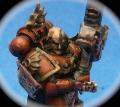Again, going back to my standards (
Striker/
Striker II/
Command Decision for WWII - Sci-Fi, and
Hoplon for Ancients/Medievals/Fantasy):
for the former (WWII - Sci-Fi) you have a combination of Written Orders, and
IGOUGO with Reaction.
But because of the written orders, the players are highly constrained in their actions.
With
Hoplon you have a combination of Alternative Actions, combined with Initiative, with the option for an Interrupt.
AND. . . the actions themselves are split into a variety of categories (Charge/Routs, Regular Movement, Break-off).
So, each player, by order of Initiative (I will come back to that) declares Charges. If a player declares a charge with a Unit in a command, then that command has "Seized the Initiative" and must then perform all other actions (Regular Movement, and Break-offs) by order of their initiative.
However, a player with a higher initiative can offer to surrender that initiative, until another player has moved, and if another player moves, they can then "Seize the Initiative" and interrupt that player's moves to perform their own.
This occurs with each action phase for movement.
MB
Automatically Appended Next Post:
 Paradigm wrote:
Paradigm wrote: Easy E wrote:
Easy E wrote:
Also, how does the setting/time period of the game fundamentally alter the type of Turn Sequence you decide to use? Is there a correlation?
In general, I think that the more modern/futuristic a setting is, the more it benefits from quick switching between players, reactions, interrupts ect simply as units tend to be smaller, more autonomous and generally freer in movement. You can easily see how a squad of a dozen men in a firefight could react quickly to the battle just on sight and/or instant commands via radio ect, thus lending itself to faster turns. Meanwhile manoeuvring a Fantasy/historical army is far less instant; you'd need a great deal of flag waving, bugle blowing, order yelling and such to get a block of 60 men to reform, hence the connection to longer turns, perhaps requiring more foresight as more can happen between now and your next go.
Of course, those aren't prescriptive. Scale also comes into it (skirmishes will naturally suit faster swaps, while mass battles even in a futuristic setting suit longer turns), and I think the further the player is supposed to 'be' up the Command structure, the longer/more spaced out turns should be. For example, in Infinity 'you' represent the strike team leader, giving orders and reacting on an action-by-action basis, whereas in something like Epic where you're essentially the overall commander leading from a base or even orbit, you're concerned more with large scale ebb and flow, and events are going to unfold more slowly, both in 'reality' and in the game.
For just 60 men (6 lines of ten men, or roughly ten yards by four yards - roughly the size of a medium apartment), you only need one guy saying "March" or "Turn Left" to get them moving.
Most Ancient Units were units of hundreds or thousands of men. For instance, the Cohort of the Later Republican, and Early Imperial Roman Army was 600 - 1000 men, and this was the field maneuver unit for the army (They then broke down into 6 - 10 centuries of 100 men each).
And, when you look further back in time, at the Hoplite Greeks, the Taxeis or Moros was roughly 1000 Hoplites or Phalangites. And for Ancient Persia or India, you saw "Units" that were 10,000 men strong.
During the Dark Ages, we saw a reduction of Set-Piece Battles, and thus in the sizes of units.
But 60 men would not be large enough to be a unit of Heavy Infantry on their own. Even if the individual soldiers were heavily armored, they would fight as Skirmishers, for the most part, using mobility as a primary defense.
You would need at least 4x that number of men before you could effectively use a "Unit formation" of Heavy or Medium Infantry (where the mass maneuver of the unit was a question - and keeping in formation was important).
If you look at the development of Ancients War-games rules by people who actually made the study of ancient warfare their business, then you can see these discussions over the issue of the basic maneuver unit of an army existing as far back as the 1980s on Usenet (with the number 200 - 400 men being agreed upon as the smallest number for which formation maintenance would be an issue).
MB